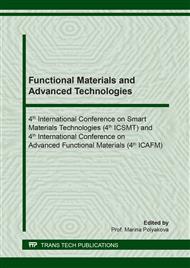[1]
K. Kumar, R. S. Gill & U. Batra, Challenges and opportunities for biodegradable magnesium alloy implants, Materials Technology, Vol 33:2, 2018, 153-172.
DOI: 10.1080/10667857.2017.1377973
Google Scholar
[2]
H. Tapiero, K.D. Tew, Trace elements in human physiology and pathology: zinc and metallothioneins, Biomedicine and Pharmacotherapy, Vol 57, 2003, 399-411.
DOI: 10.1016/s0753-3322(03)00081-7
Google Scholar
[3]
K. Guan, B. Li, Q. Yang, X. Qiu, Z. Tian, D. Zhang, D. Zhang, X. Niu, W. Sun, X. Liu, J. Meng, Effects of 1.5 wt% samarium (Sm) addition on microstructures and tensile properties of a Mg−6.0Zn−0.5Zr alloy, Journal of Alloys and Compounds, Vol 735, 2018, 1737-1749.
DOI: 10.1016/j.jallcom.2017.11.315
Google Scholar
[4]
H. Du, Z. Wei, X. Liu, E. Zhang, Effects of Zn on the microstructure, mechanical property and bio-corrosion property of Mg–3Ca alloys for biomedical application, Materials Chemistry and Physics, Vol 125, 2011, 568-575.
DOI: 10.1016/j.matchemphys.2010.10.015
Google Scholar
[5]
E. Zhang, D. Yin, L. Xu, L. Yang, K. Yang, Microstructure, mechanical and corrosion properties and biocompatibility of Mg–Zn–Mn alloys for biomedical application, Materials Science and Engineering C, Vol 29, 2009, 987-993.
DOI: 10.1016/j.msec.2008.08.024
Google Scholar
[6]
L. Xu, G. Yu, E. Zhang, F. Pan, K. Yang, In vivo corrosion behavior of Mg‐Mn‐Zn alloy for bone implant application, Journal of Biomedical Materials Research Part A, Vol 83(3), 2007, 703-711.
DOI: 10.1002/jbm.a.31273
Google Scholar
[7]
D. Yin, E. Zhang, S. Zeng, Effect of Zn content on microstructure, mechanical properties and fracture behavior of Mg-Mn, China Foundry, Vol 6(1), 2009, 43-47.
Google Scholar
[8]
B. Zhang, Y. Hou, X. Wang, Y. Wang, L. Geng, Mechanical properties, degradation performance and cytotoxicity of Mg–Zn–Ca biomedical alloys with different compositions, Materials Science and Engineering C, Vol 31, 2011, 1667–1673.
DOI: 10.1016/j.msec.2011.07.015
Google Scholar
[9]
E. Zhang, L. Yang, J. Xu, H. Chen, Microstructure, mechanical properties and bio-corrosion properties of Mg–Si(–Ca, Zn) alloy for biomedical application, Acta Biomaterialia, Vol 6, 2010, 1756-1762.
DOI: 10.1016/j.actbio.2009.11.024
Google Scholar
[10]
E. Zhang, L. Xu, G. Yu, F. Pan, K. Yang, In vivo evaluation of biodegradable magnesium alloy bone implant in the first 6 months implantation, Journal of Biomedical Materials Research Part A, Vol 90(3), 2009, 882-893.
DOI: 10.1002/jbm.a.32132
Google Scholar
[11]
H. Ibrahim, N. S. Moghaddam, M. Elahinia, Mechanical and In Vitro Corrosion Properties of a Heat-Treated Mg-Zn-Ca-Mn Alloy as a Potential Bioresorbable Material, Advances in Metallurgical and Material Engineering, Vol 1(1), 2017, 1-7.
DOI: 10.36959/508/392
Google Scholar
[12]
Y. F. Zheng, X. N. Gu, F. Witte, Biodegradable metals, Materials Science and Engineering R, Vol 77, 2014, 1-34.
Google Scholar
[13]
M. Mezbahul-Islam, A. O. Mostafa, and M. Medraj, Essential magnesium alloys binary phase diagrams and their thermochemical data, Journal of Materials, Vol 2014, 2014, Article ID 704283, http://dx.doi.org/10.1155/2014/704283, 33 pages.
DOI: 10.1155/2014/704283
Google Scholar
[14]
H. Okamoto, Supplemental literature review of binary phase diagrams: Cs-In, Cs-K, Cs-Rb, Eu-In, Ho-Mn, K-Rb, Li-Mg, Mg-Nd, Mg-Zn, Mn-Sm, O-Sb, and Si-Sr, Journal of Phase Equilibria and Diffusion, Vol. 34, 2013, 251–263.
DOI: 10.1007/s11669-013-0233-2
Google Scholar
[15]
L. Fang, X. Zhang, L. Ren, H. Hu, X. Nie and J. Tjong, Effect of Ni addition on tensile properties of squeeze cast Al alloy A380. Advances in Materials and Processing Technologies. Vol 4(2), 2018.200-209.
DOI: 10.1080/2374068x.2017.1411746
Google Scholar
[16]
X. Zhang, L. Fang, H. Hu, X. Nie, and J. Tjong, Determination of Metal/die Interfacial Heat Transfer Coefficients in Squeeze Casting of Wrought Aluminum Alloy 7075 with Variations in Section Thicknesses and Applied Pressures. Journal of Heat Transfer, Vol 139, 2017, 022101-1-022101-9.
DOI: 10.1115/1.4034855
Google Scholar
[17]
J. Zhou, L. Ren, X. Geng, L. Fang, H. Hu, As-cast magnesium AM60-based hybrid nanocomposite containing alumina fibres and nanoparticles: microstructure and tensile behavior. Materials Science & Engineering A, 2017, In Press.
DOI: 10.1016/j.msea.2017.10.070
Google Scholar
[18]
M. Masoumi, H. Hu, Influence of Applied Pressure on Microstructure and Tensile Properties of Squeeze Cast Magnesium Mg-Al-Ca alloy, Materials Science and Engineering A, Vol 528(10-11), 2011, 3589-3593.
DOI: 10.1016/j.msea.2011.01.032
Google Scholar
[19]
S. Cai, T. Lei, N. Li, F. Feng, Effects of Zn on microstructure, mechanical properties and corrosion behavior of Mg–Zn alloys, Materials Science and Engineering C, Vol 32, 2012, 2570-2577.
DOI: 10.1016/j.msec.2012.07.042
Google Scholar
[20]
T. J. Collins, ImageJ for microscopy,, BioTechniques, 2007, vol. 43, no. 1, pp. S25-S30.
DOI: 10.2144/000112517
Google Scholar
[21]
J. Hu and X. Nie, Effect of nanostructure oxide coatings on tensile properties of cast pure magnesium, Advanced Materials Research, Vol 1088, 2015, 18-22.
DOI: 10.4028/www.scientific.net/amr.1088.18
Google Scholar


